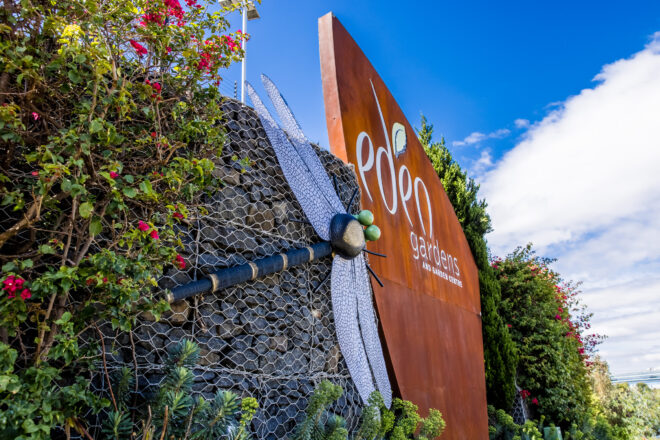
Stuart Read reviews a sculpture exhibition at Eden Gardens & Garden Centre, 307 Lane Cove Road (cnr. Fontenoy Road), Macquarie Park, Sydney until April 2022 or @ Eden Unearthed – Eden Gardens
I have visited this outdoor sculpture exhibition curated by Meredith Kirton (an AGHS member) once actually, but several more times virtually. So even if you don’t live in Sydney you can get to Eden Unearthed – Eden Gardens.
A collaboration between artists and place, its 35 works range in size, with each responding to or interacting with a one-hectare, intriguingly varied, site. Many use recycled materials or plant products: they speak to issues of the day, like climate change, fire, drought, floods, COVID lockdowns. This is just what good art should do – question, respond, challenge. Along with 10 permanent sculptures, Eden Gardens has plenty of ‘lure’ , even depth if you’re for delving, and plenty of fun… a special children’s art trail and child-friendly signage widens its appeal. It also has a large garden centre, retail area, café and restaurant.
Graham Forsyth, one of three Eden Unearthed judges and an honorary associate professor at UNSW Arts, Design and Architecture says of it ‘…the flow is both ways: the gardens and spaces allow the works of art to be enlivened and made rich with meaning, while the works support the idea of the garden as green, living, fluid and complex’.
This is Australia’s largest privately funded exhibition of its kind. Sponsorships help support it and mean that artists can have a public airing in a place where people perhaps not inclined to go to art galleries will bump into and discover imaginative artworks. Outreach programs including community group and school visits, hands-on guided tours and workshops extend Eden Gardens’ reach – all fine things.
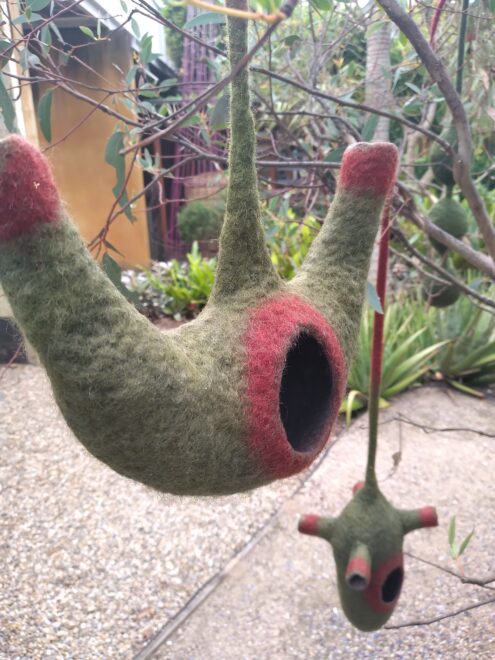
What pleased me was that this year a textile artist won first prize: Saskia Everingham for ‘Refuge‘. It was my favourite. Felt shapes (cocoons, cubbies, pods, nests, fruit?) hang from a small mallee-type eucalypt. They symbolise homes for displaced wildlife and people in response to the shocking 2019 fires in the Blue Mountains, where Saskia lives. She says: ‘My family was evacuated, and I was aware – for weeks – of large flocks of birds circling in the air, looking for homes, as theirs had been destroyed. So, my work was an offering of refuge for not only the birds but for all people who are currently wandering homeless. It is an issue that will not go away soon.’
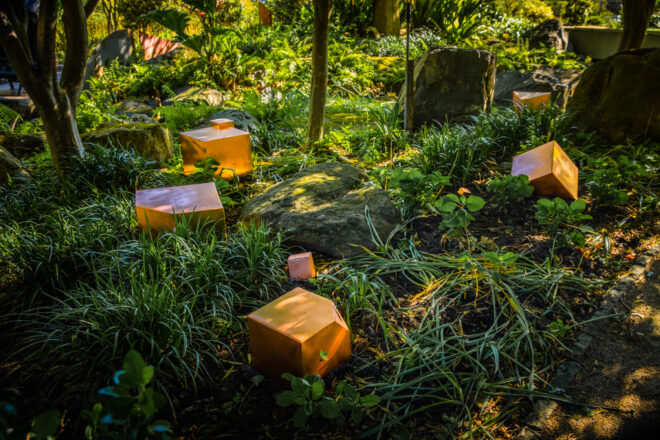
Other works catching this reviewer’s eye were ‘Fool’s Gold: prospecting in the garden’ by Selina Springett and Alessandro Berini, a playful take on mining in Australia – using geometric shapes of pyrite or fool’s gold; ‘The Drop’, by Simone Leonelli, a metallic, reflective form, hanging from gum trees like a huge raindrop, focusing attention on the oceans and water (and droplets of the COVID-19 virus); and ‘Seed Bank’, a floating stage-set on the garden’s striking ‘screw-form’ reservoir, with landing platform and ladder, offering a virtual portal into an imagined subterranean, sub-aquatic, seed bank. The piece reminds viewers that our botanical diversity and all the life it supports (including crop and fibre plants for human benefit) is increasingly under threat from climate change and rapaciousness. Your eyes may seek and rest on others;there are plenty of them.
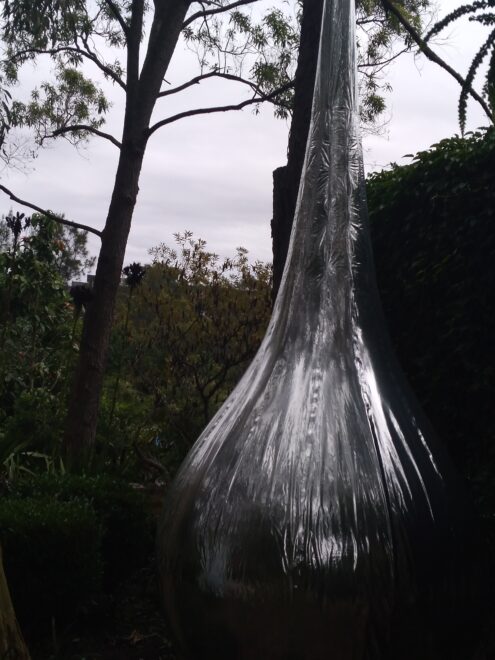
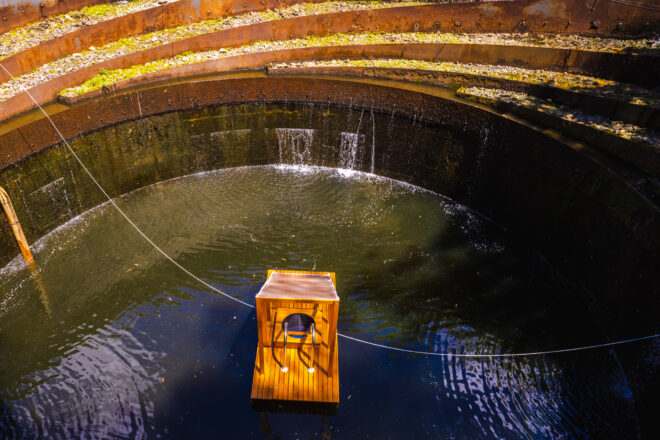
This site is on Cammeraygal Dharug Country, formerly thickly forested with Sydney sandstone ridgetop woodland community flora, including Sydney blue gum/smooth-barked apple (oak) (Angophora costata); red bloodwood (Corymbia gummifera) and scribbly gum (Eucalyptus gummifera) canopy. Most pleasingly, as part of the 2019 exhibition, Dharug artist Shannon Foster, working with Youth off the Streets, carved the trunks of some of the red bloodwood trees on site, re-asserting Dharug ties and building cultural skills in youth. This same artist has been instrumental in the Guriwal Arts & Culture trail in Sydney’s Centennial Park and is part of the NSW State Library exhibition and research project, Dyarubbin, about the Hawkesbury River’s long Dharug occupation and associations.
After colonisation the area was part of the Field of Mars Common, later subdivided for orchards, market gardens, poultry, and pig farming to service the city. Orcharding had ceased by the 1970s and market gardening therafter. A brick pit was on part of the site from 1978. Reserved for construction of the M2 motorway (short-cutting Sydney’s mid-north as part of an orbital), the land became surplus and was rezoned to business special zone (research and development), allowing integrated horticultural facilities. The site’s east adjoins Lane Cove National Park; buffer plantings are of locally native species.
The overall landscape design was by Jon Shinkfield (of Pittendrigh, Shinkfield, Bruce: PSB). He designed the impressive site reservoir that gives reference to the Coriolis spiral. The Gardens are in the south-eastern part of the site, with permanent features and changing seasonal displays in variously themed ‘sub’ gardens. These draw on historic garden influences and fuse contemporary Australian and European design. Horticulture is a strong theme, borne from collaborating with the Royal Botanic Gardens, Sydney. A long lawn axis bisects the gardens’ south, offering a transect through informal woodland gardens and native bush gardens with many red bloodwood trees retained. The central and western gardens are formally laid out. A ‘Green Theatre’ in the south-east is used by varied entities for education and training, demonstrations, talks and entertainment. The main nursery/café/shop roof is an early ‘green roof’, with 33 individual plant-covered panels forming a fan shape that dramatically mark the building’s entrance.
In all, a feast for the eyes and mind and well worth a real, or a virtual, visit and ponder. You’ve got until April.
More information, catalogue, interviews, workshops (January & April, timed for school holidays) are at Eden Unearthed – Eden Gardens and photos at #edenunearthed and #edenunearthed2021

